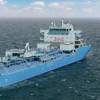Seaborne shipments passed 10 billion tons for the first time ever in 2015, up 2.1 per cent from 9.8 billion tons the year before, the UNCTAD Review of Maritime Transport 2016 says, noting that this is the slowest pace of growth in the industry since 2009 and that future growth looks uncertain.
Shipping carried more than 80 per cent of the world's goods by volume in 2015, and its slow growth reflects sluggish global trade, albeit with variations in the different sectors.
Shipping of oil recorded its best performance since 2008, thanks to low oil prices, ample supply and stable demand. But shipping's overall growth was dragged down by the limited growth of dry bulk commodity trade, in particular coal and iron ore, and by the poor performance of container shipping, which carries about 95 per cent of the world's manufactured goods.
Despite this slow growth, the industry's carrying capacity continued to grow, jumping 3.5 per cent to 1.8 billion deadweight tons in 2015 and pushing freight rates down to record lows. In September 2016, the container market suffered its worst ever bankruptcy with the loss of Hanjin Shipping, the sector's seventh biggest carrier.
"With global trade growing at its slowest pace since the financial crisis, the immediate outlook for the shipping industry remains uncertain and subject to downside risks," UNCTAD Secretary-General Mukhisa Kituyi said, ahead of the report's launch on 7 November.
"The push for ever larger ships is at the root of the industry's problems," he added. "There's just not enough cargo right now to fill the newly acquired, bigger vessels."
Falling demand from China, low commodity prices, over supply of ships and geopolitical uncertainties in some oil and gas producing countries all add to the current downside risks affecting shipping.
Shipping companies have sought to reduce their operating costs by building and buying ever larger ships. But this may prove costly for developing countries, where transport costs are already higher than in other regions. With larger ships, total system costs go up, and smaller trading nations are increasingly confronted with oligopolistic liner markets.
Developing countries account for ever larger shares of international shipping. By volume, they accounted for 60 per cent of the goods loaded onto ships in 2015. In the same year, their share of goods unloaded was 62 per cent, up from 41 per cent in 2006.
With the exception of a few Asian countries such as China, most developing country ports lack the infrastructure for bigger ships. So unless they spend heavily on upgrading their ports, developing countries face fewer port calls, less competitive markets and higher shipping costs.
But thanks to population growth, and the potential maritime trade and business opportunities that may be generated by new transport infrastructure projects such as the extension of the Panama Canal and Suez Canal, the long-term prospects for shipping remain positive, the report says. It urges developing countries to identify possible comparative advantages in sectors such as shipbuilding, registration and staffing, and to benefit from them.
"With all the bad news in the media about the state of the shipping industry, we forget that seaborne trade continues to grow, offering job and growth opportunities for developing countries," says Shamika N. Sirimanne, Director of the UNCTAD Division on Technology and Logistics.
Developing countries can also cut their costs by keeping their ports competitive.
"Many industries and businesses in developing countries could be much more competitive if their ports were more efficient," Ms. Sirimanne says, adding that delays in African ports add roughly 10 per cent to the cost of imported goods and even more to exports.
The UNCTAD port training programme currently works with some 200 ports in 29 countries in Africa, Asia and Latin America, helping them to improve performance through management training, research projects and keeping up to date with the latest port legislation.
Shipping accounts for almost 3 per cent of greenhouse gas emissions today, but as the industry grows its emissions could jump by 50-250 per cent by 2050. Despite this, it remains one of the few sectors not regulated under the United Nations Framework Convention on Climate Change. But with the Paris Agreement on climate change coming into force on 4 November, and this month's twenty-second Conference of the Party - COP 22 - meeting, shipping will be increasingly in the spotlight.














